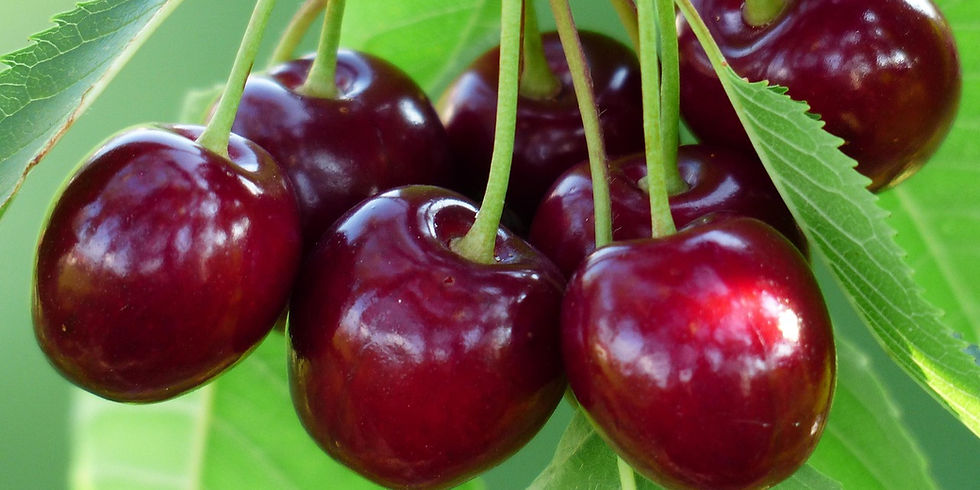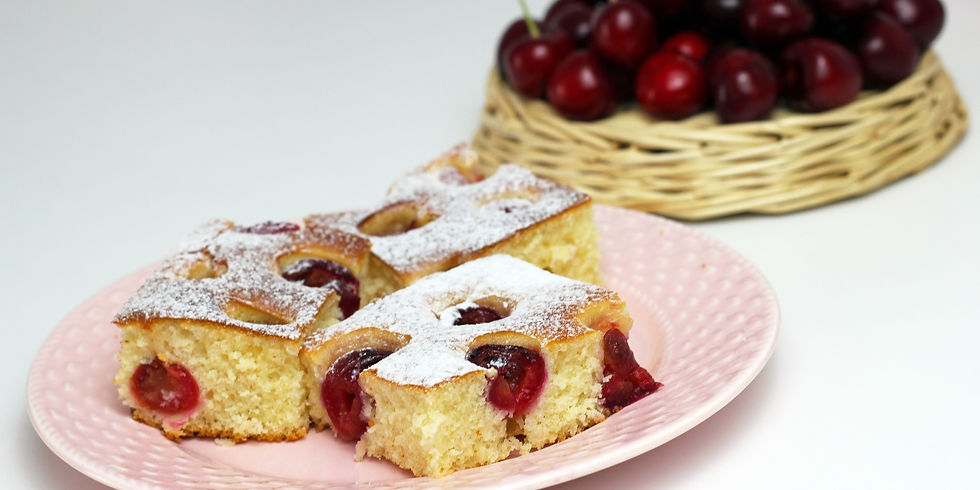Cherry
- The Economic Botanist

- Aug 11
- 7 min read
Scientific name: Prunus avium (sweet cherry), Prunus cerasus (sour cherry)
Family: Rosaceae

You might think of cherries as a sweet summertime treat or the perfect pie filling—but this vibrant fruit is much more than just dessert. Cherries have a deep-rooted history, fascinating botany, and surprising benefits for both people and ecosystems.
In this Plant Compendium entry, we’re diving into the world of cherry trees. Whether you're a gardener, forager, or just cherry-curious, we’ll keep things accessible and grounded in good science—with just a sprinkle of friendly horticultural banter. Ready to branch out? Let’s explore the cherry tree together.
History of Cherry
Cherries have been cultivated for thousands of years. Ancient Romans and Greeks prized them for their beauty and taste, and the trees made their way through Asia, Europe, and eventually into North America with early colonists. George Washington might not have really chopped down a cherry tree, but the legend shows just how embedded these trees are in cultural lore.
Today, cherry trees are found in home gardens, orchards, and cityscapes alike—prized for their blossoms just as much as their fruit. Sweet cherries (Prunus avium) are typically enjoyed fresh, while sour cherries (Prunus cerasus) are used in baking, preserves, and traditional medicines.
Botanical Description
Cherry trees belong to the same family as roses, apples, and almonds. They're deciduous, meaning they shed leaves in winter, and they typically bloom in early spring with a spectacular floral show.
Roots: Cherry trees develop a fairly shallow but wide root system. They prefer well-drained soil and don’t tolerate soggy conditions. Taproots are uncommon, especially in grafted trees.
Trunk & Bark: Mature trees can grow up to 10–15 meters (33–50 feet) tall, though many orchard varieties are pruned smaller. The bark is often shiny and reddish-brown, with horizontal lenticels (tiny pores for gas exchange).
Leaves: Oval to lance-shaped with finely serrated edges. Glossy and dark green in summer, turning golden-yellow to reddish-orange in fall.
Flowers: Clusters of five-petaled white or pink blossoms appear in early spring, before the leaves fully emerge. Flowers are not only beautiful—they're vital for pollination.
Fruit: Cherries are small, round drupes (stone fruits), usually red to dark purple when ripe. Sweet cherries are firm and sugary, while sour cherries are softer and tangy.
Seeds: Each cherry contains one hard pit or "stone." Fun fact: cherry pits contain amygdalin, a compound that can release cyanide when crushed—more on that in the safety section.

Growing Instructions
Thinking about planting a cherry tree? Here's what you need to know:
Sunlight: Full sun is a must—at least 6–8 hours per day. This helps ensure strong flowering and fruiting.
Soil: Well-drained, loamy soils with a slightly acidic to neutral pH (6.0–7.0) are ideal. Avoid heavy clay or waterlogged areas.
Temperature: Most cherry trees need a certain number of "chill hours" (exposure to cold temps below 7°C/45°F) in winter to flower properly. They thrive in temperate climates.
Watering: Keep soil evenly moist, especially during establishment and fruiting. Once mature, cherry trees are moderately drought-tolerant.
Spacing: Standard trees need 7–9 meters (20–30 ft) between them. Dwarf varieties can be planted 3–4 meters apart.
Pruning: Prune in late winter to maintain shape, remove crossing branches, and improve airflow. Summer pruning can help control size.
Pollination: Some varieties are self-pollinating (like 'Stella'), but most sweet cherries need a second, compatible variety nearby. Sour cherries are usually self-fertile.
Life Cycle:
Year 1–2: Establishment; minimal fruiting.
Year 3–5: Blossoms appear; light fruiting begins.
Year 6+: Full production; fruit ripens in early to mid-summer.
Dormant season: Leaves drop; tree rests for the next bloom cycle.
Harvesting and Foraging
Harvesting
When: Cherries ripen in early to mid-summer, depending on the type and your climate.
How: Pick by the stem to avoid damaging the fruit. Use a gentle twisting motion or small scissors.
Signs of ripeness: Glossy skin, full color, and a juicy feel. Sweet cherries should be firm; sour cherries slightly soft.
Foraging
Wild cherries (Prunus serotina, Prunus virginiana) can be foraged in some regions, but know your ID! Many wild relatives are bitter or mildly toxic. Always double-check with a trusted field guide.

Plant Companions
Cherries do best with thoughtful garden neighbors.
Good companions:
Chives & garlic: Help deter aphids and borers.
Dandelion & comfrey: Improve soil health and attract pollinators.
Nasturtium: Draws away pests and looks lovely around the base.
Not-so-great neighbors:
Tomatoes & peppers: Share similar pests like aphids and hornworms.
Black walnut: Its roots release juglone, which can stunt cherry tree growth.
Common Pests and Diseases
Cherries are delicious—but pests think so too.
Pests:
Cherry fruit fly: Larvae tunnel into the fruit. Yellow sticky traps can help detect and reduce populations.
Aphids: These small bugs cause leaf curling and sticky residue. Encourage beneficial insects or use neem oil.
Birds: Netting or scare tactics (like shiny tape) may be needed to save your crop.
Diseases:
Brown rot: A fungal infection that ruins flowers and fruit. Prune regularly and remove fallen debris.
Leaf spot: Causes small holes or yellowing leaves. Copper sprays can help.
Powdery mildew: Looks like white dust. Improve airflow and avoid overhead watering.
Shopping Tips
When buying cherry trees or seeds:
Trees: Look for bare-root or potted trees from reputable nurseries. Make sure the rootstock matches your climate and space.
Varieties: Choose based on taste (sweet vs. sour), pollination needs, and local climate. Ask for chill hour info if you’re in a warmer region.
Seeds: Growing from pits is tricky and inconsistent. Grafted trees are usually a better bet for fruit.
Storage
Cherries are highly perishable—treat them gently.
Fresh cherries: Store unwashed in the fridge, ideally in a shallow container. Wash just before eating. Lasts 4–7 days.
Freezing: Pit cherries first. Freeze on a tray, then transfer to airtight bags.
Drying: Use a dehydrator or low oven to make tart cherry snacks.
Preserves: Sour cherries make excellent jam, syrup, and pie filling. Sweet cherries can be canned or pickled.

Culinary Uses
Cherries are not only beautiful to look at but also incredibly versatile in the kitchen. Whether you prefer sweet or tart cherries, there are countless ways to enjoy their juicy, vibrant flavor. Here’s a deep dive into some of the tastiest and most creative ways to bring cherries to your table:
Fresh Eating: Nothing beats the pure, fresh taste of ripe cherries straight from the tree or market. Sweet cherries like Bing and Rainier are perfect for snacking, while tart cherries add a lively punch to fresh fruit salads. When buying fresh cherries, look for firm, glossy skin and stems that are green and flexible.
Baking and Desserts: Cherries shine in desserts, adding natural sweetness and a hint of tartness. Classic cherry pie is a beloved favorite, but don’t stop there—try cherry clafoutis (a French baked custard), cherry tarts, or even cherry cobblers and crisps topped with crunchy oats and nuts. Frozen cherries work wonderfully in baked goods too, giving you a taste of summer year-round.
Sauces and Jams: Cooked down, cherries transform into rich sauces perfect for both sweet and savory dishes. Cherry sauce pairs beautifully with vanilla ice cream or pancakes, and it’s also fantastic drizzled over roasted meats like duck or pork for a gourmet touch. Homemade cherry jam or preserves capture the essence of the fruit and are delicious on toast or stirred into yogurt.
Drinks and Smoothies: Cherries can elevate beverages in many ways. Fresh or frozen cherries blended into smoothies add color, flavor, and nutrition. Cherry juice is a natural thirst quencher and is sometimes used for its anti-inflammatory benefits. You can also infuse cherries into water, make cherry lemonade, or create cocktails and mocktails with cherry syrup or fresh muddled cherries for a refreshing twist.
Cooking and Savory Dishes: Don’t limit cherries to sweets—tart cherries especially have a place in savory cooking. Add dried or fresh cherries to salads for bursts of sweetness, toss them into grain bowls, or use cherry chutney as a condiment alongside cheese and charcuterie. Cherry compotes and reductions also brighten up dishes like grilled chicken, pork tenderloin, or even pizza, pairing well with strong cheeses like goat cheese or blue cheese.
Freezing and Preserving: Cherries freeze beautifully, preserving their flavor and texture for later use. Simply pit and wash them, then freeze in a single layer on a baking sheet before transferring to freezer bags. This method keeps them from clumping together, making it easy to grab a handful for smoothies or baking. You can also preserve cherries by canning, drying, or making cherry-infused syrups.
Cherry Leaves and Flowers: While the fruit steals the spotlight, cherry leaves and blossoms are edible and offer unique culinary uses. Cherry blossoms are popular in Japanese cuisine for making sakura tea, sweets, or even pickled treats. Cherry leaves can be used to wrap sweets like Japanese sakura mochi, imparting a subtle fragrance.
Cherries are truly a kitchen superstar, lending their delightful flavor and beautiful color to everything from simple snacks to sophisticated dishes. Whether you’re a seasoned cook or just starting your culinary adventure, cherries are a fantastic ingredient to experiment with and enjoy.
Health Benefits
Cherries are small but mighty.
Antioxidants: Rich in anthocyanins and vitamin C—supporting immune health and reducing oxidative stress.
Anti-inflammatory: May help reduce muscle soreness and arthritis symptoms.
Sleep support: Tart cherries contain melatonin, which may improve sleep quality.
Heart health: Potassium and polyphenols help regulate blood pressure and reduce cholesterol.
Toxicity and Safety
For the most part, cherries are safe and healthy to eat—but there are a few precautions.
Pits: Contain amygdalin, which can release cyanide in the body. Don’t crush or chew them. Swallowing one whole isn’t dangerous, but keep pits away from small children and pets.
Allergies: Rare, but oral allergy syndrome can affect some people with birch or grass pollen sensitivities.
Tree parts: Leaves, stems, and seeds all contain small amounts of toxins. Stick to the fruit.

Environmental Impact
Cherry trees contribute more than just fruit to the landscape.
Pollinator magnet: Spring blossoms attract bees, butterflies, and other pollinators.
Carbon capture: Like other trees, cherries help store carbon and improve air quality.
Habitat: Birds and insects love cherry trees—just be prepared to share some fruit.
Erosion control: Roots help stabilize soil, especially on sloped terrain




Comments